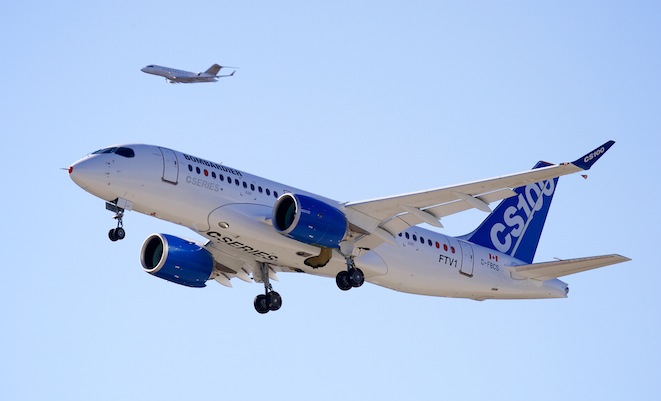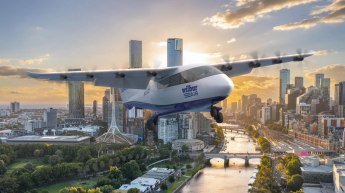
Bombardier says flight testing of its new CSeries has resumed after the three-month grounding due to an engine fire, with the program on track to enter commercial service in the second half of 2015.
CSeries aircraft flight test vehicle two (FTV2) took off from Bombadier’s Mirabel facility in the Canadian province of Quebec on September 7, the company said in a statement.
Bombardier commercial aircraft vice president of the CSeries aircraft program Rob Dewar said the company was pleased to have the aircraft back in the air.
“The geared turbofan (GTF) engine has over 10,000 hours of ground and flight testing and we’re confident that it will enter into service meeting or exceeding the fuel burn, emissions, thrust and noise specifications, as promised by Pratt & Whitney,” Dewar said in a statement.
“Aircraft flight test programs are complex and involve extreme testing meant to draw out any potential issues and correct them prior to entry-into-service.”
The CSeries flight test program’s four test aircraft were grounded after FTV1 suffered an engine fire during stationary ground maintenance testing on May 29.
Bombardier said it and Pratt & Whitney had taken “appropriate measures to address the issue, including the modification of the engine’s oil lubrication system”.
“The CSeries aircraft’s entry-into-service remains on track for the second half of 2015,” Bombardier said.
The CSeries program, which had received 203 firm orders, suffered a blow in late August when Sweden’s Braathens Aviation said it would no longer be the launch customer of the new aircraft.
Apart from the recent unconfined engine failure, the CSeries program had also experienced a number of delays and in mid-August Bombardier made a series of changes to its executive team, including the replacement of vice president of marketing for Bombardier’s commercial aircraft division Philippe Poutissou.
Bombardier also announced a corporate restructure which involved the loss of 1,800 jobs and the splitting of its aerospace division into three separate units – business aircraft, commercial aircraft and aerostructures and engineering services.
The C100 was designed to seat 110 passengers in a single-class configuration, while the larger C300 could fit 135 seats, based on 32in seat pitch, according to the Bombardier website.
















James in Sydney
says:Can anyone explain what that thing is that hangs off the tail of test aircraft?
Alan
says:It is called a “Trailing Cone” and is used for calibrating the static pressure in the undisturbed airflow, as opposed to the disturbed airflow around the static sensors which measure the static pressure in normal operation. This can be used to calculate the error in the aircraft’s static system as it provides an accurate measurement of the static pressure (ambient atmospheric pressure) well clear of the aircraft’s fuselage.